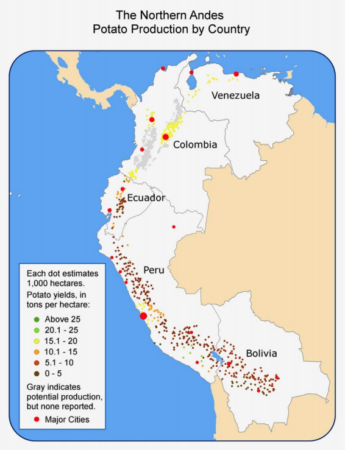- The Food Systems Dashboard is a new tool to inform better food policy. 140 indicators from over 30 sources. Launching soon. Always good to have the data.
- Using Living Germplasm Collections to Characterize, Improve, and Conserve Woody Perennials. Nice review of the conservation of your favourite fruits in field genebanks (about 6% of the total number of crop accessions).
- Moving threatened plants: Story and practice. It sounds easy but it isn’t.
- Seed Germination after 30 Years Storage in Permafrost. Drying, drying, drying.
- Why Seed Physiology Is Important for Genebanking. Well, don’t you want to know why a seed lot is showing no or low germination after 30 years in permafrost? Or, alternatively, how long another one will continue to show good germination? Thought so.
- Habitat management alternatives for conservation forests in the temperate zone: Review, synthesis, and implications. 4 intervention alternatives: minimal, traditional, non-traditional and species-based. But we need long-term studies to really know what works best. Presumably longer than 30 years. This is an old paper, but it came up again because of this very thorough Twitter thread.
- High richness of exotic trees in tropical urban green spaces: Reproductive systems, fruiting and associated risks to native species. Go native. At least in Brazil. Someone should mash up with all the papers above.
- Mashes to Mashes, Crust to Crust. Presenting a novel microstructural marker for malting in the archaeological record. Look for cell wall breakdown in the grain’s aleurone layer.
- Powerful detection of polygenic selection and environmental adaptation in US beef cattle. Local adaptation is being eroded.
- Genomic-Led Potato Breeding for Increasing Genetic Gains: Achievements and Outlook. The future is true seed-propagated F1 diploid hybrids produced by crossing inbred diploid lines. Oh, plus gene editing here and there.
- Reply to: Evaluating two different models of peanut’s origin. Did the polyploidization event which gave rise to Arachis hypogaea occur ~450,000 years ago or <10,000 years ago? The authors who said the former double down.
- Lost and Found: Coffea stenophylla and C. affinis, the Forgotten Coffee Crop Species of West Africa. Let the interbreeding commence.
- The proportion of soil-borne pathogens increases with warming at the global scale. Be afraid.
Viral Vault vids
I guess people are mainly sitting at home making videos during the lockdown. Here are two on Svalbard which dropped within a couple of days of each other, presumably in time for the International Day for Biodiversity. Which is today, isn’t it?
And you might as well complement them with this nice article from Simran Sethi.
The EU gets a new biodiversity strategy
The decline of genetic diversity must also be reversed, including by facilitating the use of traditional varieties of crops and breeds. This would also bring health benefits through more varied and nutritious diets. The Commission is considering the revision of marketing rules for traditional crop varieties in order to contribute to their conservation and sustainable use. The Commission will also take measures to facilitate the registration of seed varieties, including for organic farming, and to ensure easier market access for traditional and locally adapted varieties.
That’s from the EU’s new biodiversity policy. Promising. But I don’t see anything in there about ex situ conservation to back up this conservation-through-use approach, welcome as it is.
What makes taro an orphan crop?
Live at 2pm GMT today 21 May…
LATER: Spoiler alert. The answer to the question in the title has to do with:
- inaccurate dogmas
- multiplicity of names
- negative social bias
- lack of research
- narrow ecological niche
- archaeological invisibility
- missing numbers
Potato atlas returns to life
I have decided to relaunch the potato and sweetpotato atlas sites — completed while working with CIP, but now personal — in hope that with active collaboration, they can become more current and relevant.
That’s from the very brave Kelly Theisen, on the World Potato Atlas site. We’ll see how both develop, and do what we can to help. The country chapters from the original versions of both atlases, which date back to the 1980’s, are also on there.
